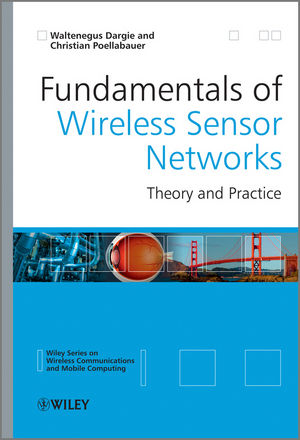Fundamentals of Wireless Sensor Networks: Theory and PracticeISBN: 978-0-470-99765-9
Hardcover
336 pages
August 2010
 This is a Print-on-Demand title. It will be printed specifically to fill your order. Please allow an additional 10-15 days delivery time. The book is not returnable.
|
||||||
Preface xvii
Part One: INTRODUCTION
1 Motivation for a Network of Wireless Sensor Nodes 3
1.1 Definitions and Background 4
1.2 Challenges and Constraints 9
2 Applications 17
2.1 Structural Health Monitoring 17
2.2 Traffic Control 26
2.3 Health Care 30
2.4 Pipeline Monitoring 35
2.5 Precision Agriculture 36
2.6 Active Volcano 38
2.7 Underground Mining 40
3 Node Architecture 47
3.1 The Sensing Subsystem 48
3.2 The Processor Subsystem 51
3.3 Communication Interfaces 58
3.4 Prototypes 62
4 Operating Systems 69
4.1 Functional Aspects 70
4.2 Nonfunctional Aspects 73
4.3 Prototypes 75
4.4 Evaluation 88
Part Two: BASIC ARCHITECTURAL FRAMEWORK
5 Physical Layer 95
5.1 Basic Components 95
5.2 Source Encoding 96
5.3 Channel Encoding 101
5.4 Modulation 106
6 Medium Access Control 125
6.1 Overview 125
6.2 Wireless MAC Protocols 128
6.3 Characteristics of MAC Protocols in Sensor Networks 133
6.4 Contention-Free MAC Protocols 135
6.5 Contention-Based MAC Protocols 144
6.6 Hybrid MAC Protocols 154
6.7 Summary 157
7 Network Layer 163
7.1 Overview 163
7.2 Routing Metrics 165
7.3 Flooding and Gossiping 168
7.4 Data-Centric Routing 170
7.5 Proactive Routing 176
7.6 On-Demand Routing 178
7.7 Hierarchical Routing 180
7.8 Location-Based Routing 183
7.9 QoS-Based Routing Protocols 192
7.10 Summary 196
Part Three: NODE AND NETWORK MANAGEMENT
8 Power Management 207
8.1 Local Power Management Aspects 208
8.2 Dynamic Power Management 216
8.3 Conceptual Architecture 222
9 Time Synchronization 229
9.1 Clocks and the Synchronization Problem 229
9.2 Time Synchronization in Wireless Sensor Networks 231
9.3 Basics of Time Synchronization 234
9.4 Time Synchronization Protocols 237
10 Localization 249
10.1 Overview 249
10.2 Ranging Techniques 250
10.3 Range-Based Localization 252
10.4 Range-Free Localization 258
10.5 Event-Driven Localization 262
11 Security 267
11.1 Fundamentals of Network Security 267
11.2 Challenges of Security in Wireless Sensor Networks 269
11.3 Security Attacks in Sensor Networks 270
11.4 Protocols and Mechanisms for Security 274
11.5 IEEE 802.15.4 and ZigBee Security 280
11.6 Summary 281
12 Sensor Network Programming 285
12.1 Challenges in Sensor Network Programming 285
12.2 Node-Centric Programming 286
12.3 Macroprogramming 293
12.4 Dynamic Reprogramming 295
12.5 Sensor Network Simulators 297
Exercises 299
References 300
Index 303



